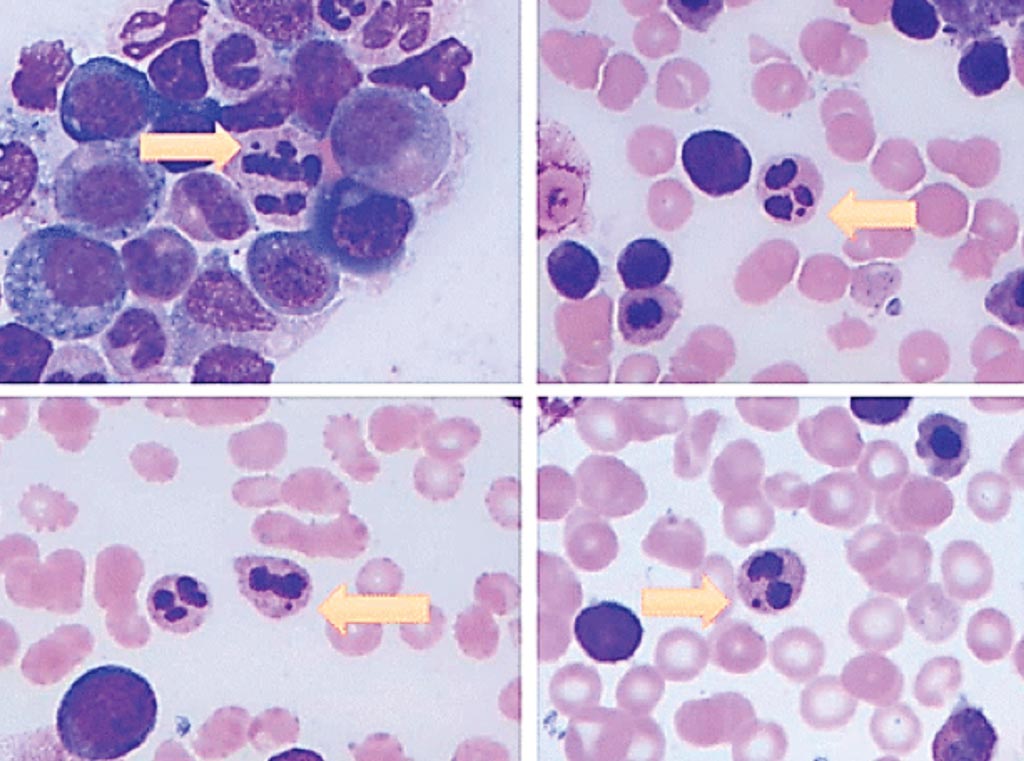Howell-Jolly Body-Like Inclusions Correlated with Myelodysplastic Syndrome
By LabMedica International staff writers
Posted on 07 Jan 2019
Howell-Jolly body–like inclusions have been previously associated with patients who are human immunodeficiency virus (HIV) infected, taking antiviral medications, and immunosuppressed. These inclusions appear in neutrophils and resemble Howell-Jolly bodies of normoblasts in abnormal erythropoiesis.Posted on 07 Jan 2019
Compared with a Barr body, which appears as a drumstick-shaped appendage of a nuclear lobe, a Howell-Jolly body-like inclusion appears as a completely detached and densely basophilic inclusion in the cytoplasm of neutrophils. Howell-Jolly body-like inclusions are thought to represent a product of dysplastic granulopoiesis.

Image: Howell-Jolly body–like inclusion within neutrophil (arrow). It appears as a completely detached and densely basophilic inclusion in the cytoplasm of neutrophil. Photos were taken from different cases (Photo courtesy of University of Texas Health Science Center at Houston).
Scientists at the University of Texas Health Science Center at Houston (Houston, TX, USA) selected as a study group a total of 11 patients who underwent bone marrow biopsy and were newly diagnosed with myelodysplastic syndrome (MDS) that were treatment naïve, between 2010 and 2017. In addition, 20 treatment-naïve patients who underwent bone marrow biopsy but were diagnosed with no significant pathologic alteration in the institution were selected as the control group.
The peripheral blood and bone marrow aspirate smears were retrospectively studied. A minimum of 300 neutrophils and myeloid precursors from each bone marrow aspirate smear and 20 neutrophils from each peripheral blood smear were screened. Each patient's clinical information from the electronic medical record was reviewed to ensure none of them had a history of HIV or was taking immunosuppressants and/or antiviral medications.
The team reported eight of 11 cases (72%) in the study group showed detached intracytoplasmic inclusions in mature neutrophils consistent with Howell-Jolly body-like inclusions. Morphologically, these inclusions are densely basophilic and are “free-floating” within the neutrophilic cytoplasm. Among the eight inclusion-positive cases, Howell-Jolly body-like inclusions were identified in less than 5% of the neutrophil population. Furthermore, Howell-Jolly body-like inclusions were identified within less than 1% of the myeloid precursor population in one of the eight inclusion-positive cases. Of the 20 cases from the control group, no Howell-Jolly body-like inclusion was identified, which suggests that Howell-Jolly body-like inclusion is associated with MDS.
The authors concluded that Howell-Jolly body-like inclusions seem to correlate with immunosuppression and antiviral therapies with nucleoside analogs. They proposed that the formation of Howell-Jolly body-like inclusions is the consequence of dysplasia, and hence its correlation not only with the abovementioned conditions, but also with MDS. The inclusions are, however, seen in only a minority of white cells (<5%), which is probably why they were not brought to practicing pathologists' awareness in the past. The study was published in the January 2019 issue of the journal Archives of Pathology & Laboratory Medicine.
Related Links:
University of Texas Health Science Center at Houston













